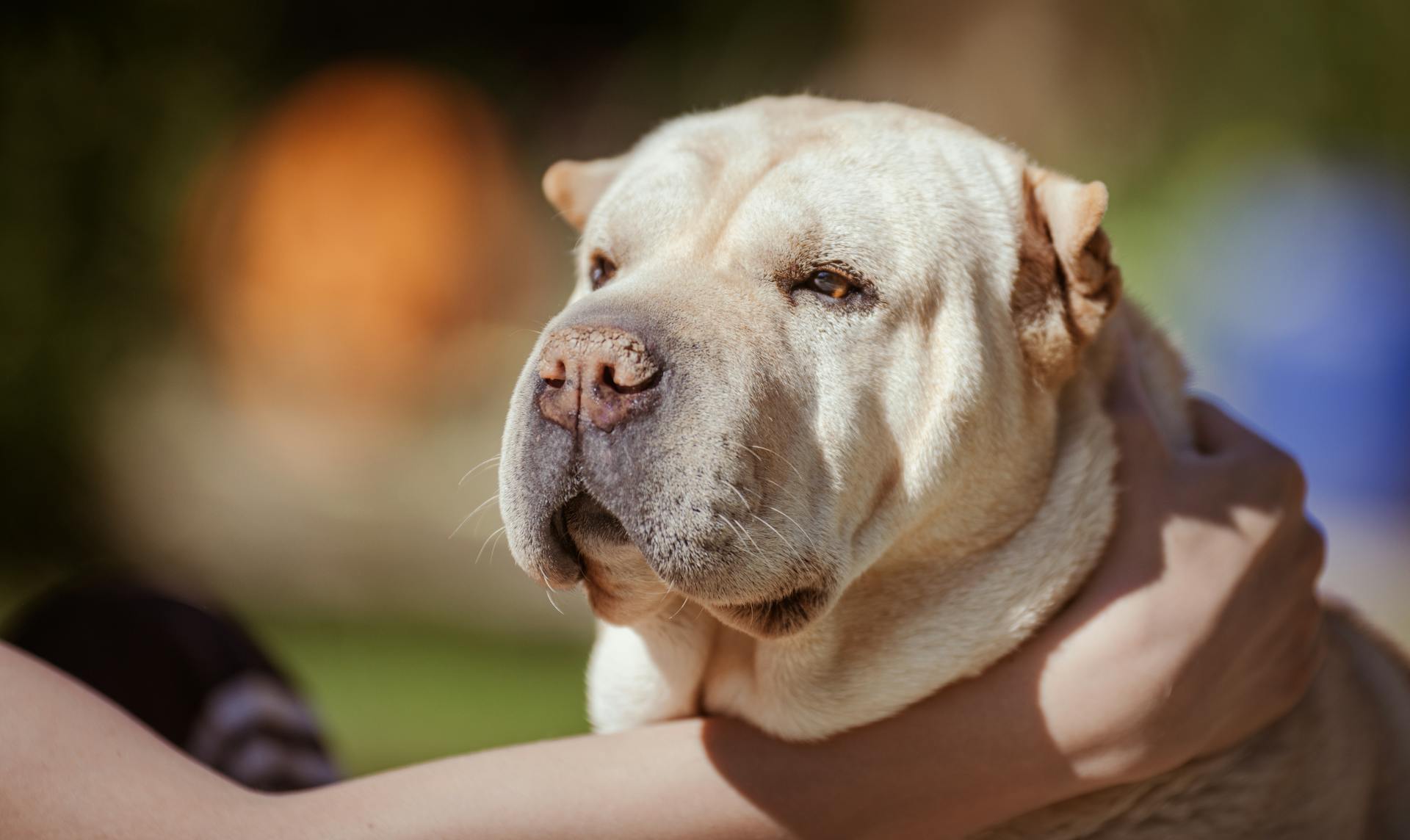
As a dog owner, it's heartbreaking to see your furry friend suffer from a hereditary disease. According to the article, some of the most common dog hereditary diseases include hip dysplasia, which affects over 40% of large breed dogs.
Hip dysplasia is a genetic condition that causes the hip joint to form improperly, leading to arthritis and mobility issues. This condition is often seen in breeds such as German Shepherds, Labradors, and Rottweilers.
In addition to hip dysplasia, other hereditary diseases include eye problems like cataracts and progressive retinal atrophy, which can cause blindness. These conditions are often inherited from a dog's parents and can be detected through genetic testing.
It's essential to work with a reputable breeder who health tests their breeding dogs to reduce the risk of passing on these diseases to their puppies.
Consider reading: Canine Follicular Dysplasia
Genetic Disorders
As a dog owner, it's essential to be aware of the genetic disorders that can affect our furry friends. Some breeds are more prone to certain health issues due to their genetic makeup.
Cavalier King Charles Spaniels and Dachshunds are at risk for myxomatous valve disease, a condition that causes heart failure symptoms like coughing, weakness, and difficulty breathing.
Certain breeds have a genetic predisposition for heart problems. For example, Doberman Pinschers, Great Danes, and Boxers are prone to dilated cardiomyopathy, which weakens and dilates the heart.
Boxers also have an inherited risk of arrhythmogenic right ventricular cardiomyopathy (ARVC), a disease that affects the heart muscle and can lead to irregular heart beats, fainting, and heart failure.
Some common genetic disorders in dogs include patella luxation, autoimmune thyroiditis, and cancer predisposition. These conditions can be inherited from a dog's parents and can lead to various health issues.
Here are some of the most common genetic disorders in dogs:
- Patella luxation
- Autoimmune thyroiditis
- Cancer predisposition (lymphoma, hemangiosarcoma, mast cell tumor, osteosarcoma)
- Hereditary cataracts
- Nonstruvite bladderstones
- Elbow dysplasia
- Cryptorchidism
- Hepatic shunts
- Epilepsy
- Glaucoma
- Deafness
- Blindness
- Renal dysplasia
- Addison disease
Hip and Joint Issues
Hip dysplasia is a common inherited musculoskeletal disorder that affects dogs of all breeds and sizes, with 14.59% of dogs submitted to the Orthopedic Foundation for Animals (OFA) rated as dysplastic.
The breeds most commonly affected include German Shepherds, Rottweilers, Bulldogs, Great Danes, Saint Bernards, Neapolitan Mastiffs, and Retrievers, with Saint Bernards having almost a 50 percent incidence.
Maintaining your dog's ideal weight is one of the most important ways to reduce the clinical signs of hip dysplasia, and weight management can also help mitigate the effects of hip dysplasia.
Some large breed dogs are at a higher risk of hip dysplasia, including those that grow faster and put on muscle mass that outpaces the growth of their skeleton, leading to an imbalance in weight distribution on the hip joint.
If you're interested in purchasing a large breed puppy, seek out a reputable breeder who has had their breeding stock radiographically evaluated by the OFA, and ask to see the certified reports on the absence or severity of hip changes.
A gentle Ortolani procedure during puppy examinations and palpation for hip laxity under anesthesia during neutering can predict hip dysplasia and later osteoarthritic changes.
Here are some breeds that are at a higher risk of hip dysplasia:
- German Shepherds
- Rottweilers
- Bulldogs
- Great Danes
- Saint Bernards
- Neapolitan Mastiffs
- Retrievers
Early identification of hip dysplasia can make a big difference, and there are hip surgeries that can restore the normal angle of the hip and mitigate the effects of hip dysplasia.
Worth a look: Hip Problems in Border Collies
Canine Hip Dysplasia
Canine hip dysplasia is a common inherited musculoskeletal disorder that affects many crossbreed and purebred dogs. Of all dogs for which radiographs are submitted to the Orthopedic Foundation for Animals, 14.59% are rated as dysplastic.
Hip dysplasia is caused by the mutation of the FGF4 gene, which has led to the classic "wiener dog" shape and associated health problems. This mutation affects the growth of the skeleton, leading to an imbalance in weight distribution on the hip joint.
Maintaining your dog's ideal weight is crucial in reducing the clinical signs of hip dysplasia. In fact, weight management can help mitigate the effects of hip dysplasia, especially if caught early.
Certain breeds are more prone to hip dysplasia, including German Shepherds, Rottweilers, Bulldogs, Great Danes, Saint Bernards, Neapolitan Mastiffs, and Retrievers. These breeds tend to grow faster and develop muscle mass that outpaces the growth of their skeleton.
Early detection is key, and a gentle Ortolani procedure during puppy examinations can predict hip dysplasia and later osteoarthritic changes. This is especially important for large breed dogs, which are at high risk of developing severe arthritis of the hip joints.
Reputable breeders use radiographic evaluations by the Orthopedic Foundation for Animals to ensure the breeding stock has healthy hips. If you're considering purchasing a large breed puppy, ask to see the OFA reports on the parents to reduce the risk of hip dysplasia.
You might like: Dog Breeds Watch Dogs
CCL Rupture
CCL rupture is a common traumatic injury that can be devastating for dogs.
Certain breeds are more prone to CCL rupture, including Rottweilers, West Highland White Terriers, Golden Retrievers, Yorkshire Terriers, Staffordshire Bull Terriers, and some crossbreed dogs.
Research shows that Newfoundlands have a 27% heritability rate for CCL rupture.
Genetic factors may contribute to CCL rupture, including issues with ligament extracellular matrix metabolism, degeneration, and/or inflammation.
Other factors may involve biomechanical and conformational variations, such as narrowed distal femoral intercondylar notches.
Heart Disease
Heart disease is a serious concern for many dog breeds. Cavalier King Charles Spaniels and Dachshunds are at risk for myxomatous valve disease, which can cause heart failure.
Myxomatous valve disease can lead to a range of symptoms, including coughing, weakness, poor appetite, and difficulty breathing. Boxers, on the other hand, are prone to dilated cardiomyopathy, a condition that causes the heart muscle to weaken over time.
Dilated cardiomyopathy can lead to heart failure and even sudden death. Doberman Pinschers and Great Danes are also at risk for this condition.
If you own one of these breeds, it's essential to have your dog screened yearly as they enter middle age. This can help catch any potential issues early on.
Some breeds, like the Cavalier King Charles Spaniel, are more prone to heart disease at a younger age. For example, they may develop myxomatous mitral valve disease at an average age of 6.25 years.
This is why some breeders are implementing generational breeding-control programs to reduce the frequency of this disorder. By only breeding dogs with parents who are free of murmurs and Doppler evidence of mitral regurgitation, they can help create healthier puppies.
Boxers are also at risk for arrhythmogenic right ventricular cardiomyopathy (ARVC), which can cause irregular heartbeats and even sudden death. Treatment for ARVC typically involves antiarrhythmic drugs and medications for heart failure.
For more insights, see: Skin Care for Dogs with Allergies
Neurological Disorders
Neurological disorders can be a challenging and distressing experience for both dogs and their owners. Epilepsy is an inheritable trait in certain dog breeds, such as German Shepherds, Beagles, and Golden Retrievers, and is managed with anticonvulsant medications.
A seizure occurs when the cells in the brain become overly excited and exceed what is called a “seizure threshold.” This can be a scary experience, but with the right medication, seizures can be managed to decrease their frequency and severity.
Degenerative myelopathy is a slowly progressive neurological condition that causes nerve fibers and their myelin sheath to deteriorate within the spinal cord. This can lead to symptoms such as weakness, wobbliness, and paralysis in the hind legs, but fortunately, affected dogs do not experience pain from the nerve deterioration.
Epilepsy
Epilepsy is a neurological disorder that can be distressing to witness in pets, especially when it's a grand mal seizure that causes stiffening, falling to the ground, salivation, and paddling of legs.
Some breeds are more prone to epilepsy due to inheritance, including German Shepherds, Beagles, Belgian Tervurens, Keeshonds, Dachshunds, Golden and Labrador Retrievers.
During a seizure, a dog's cells become overly excited and exceed the seizure threshold, leading to a loss of control.
Epilepsy is managed with anticonvulsant medications, which may be a single drug or a combination of medications tailored to the dog's needs.
Since epilepsy cannot be cured, the realistic goal of therapy is to manage seizures by decreasing their frequency and severity.
Consider reading: Epilepsy in Animals
Degenerative Myelopathy
Degenerative myelopathy is a slowly progressive neurological condition that affects the spinal cord, causing weakness, wobbliness, and paralysis in the hind legs.
The symptoms of degenerative myelopathy usually don't appear until a dog is middle-aged or in its senior years of life.
Degenerative myelopathy is devastating, but fortunately, affected dogs don't experience pain from the nerve deterioration.
However, the disease takes a psychological toll on both the dog and its owner, making it difficult for dogs to posture to urinate and defecate.
Many breeds are at risk for this inheritable condition, including German Shepherds, American Water Spaniels, and Pugs.
A blood test can predict whether a dog is clear, a carrier, or at risk for degenerative myelopathy, which can help breeders make informed decisions.
You can mitigate your risk by buying your puppy from a reputable breeder with two "clear" parents.
Respiratory Issues
Brachycephalic Syndrome is a serious respiratory issue that affects breeds with short, flat faces, such as English Bulldogs, French Bulldogs, and Pugs. These dogs often snore and snort due to anatomical abnormalities like elongated soft palates and stenotic nostrils.
Discover more: French Bulldogs and Seizures
Their breathing difficulties can be exacerbated by hot and humid weather, making it crucial to take extra precautions to keep them cool. In extreme cases, brachycephalic dogs may even experience heat stroke.
Surgical options are available to correct some of these defects, but collapsing tracheas are often irreversible. Many English Bulldogs require surgery at a young age to ensure a proper airway.
Respiratory issues in brachycephalic dogs can also lead to dental problems, skin issues, and eye problems. Regular veterinary care and maintenance are essential to prevent and manage these conditions.
BOAS, or Brachycephalic Obstructive Airway Syndrome, is a disorder that affects breathing in short-snouted breeds, including Bulldogs, French Bulldogs, and Pugs. It's caused by a mismatch in the proportions of the skull and soft tissue in the nose and pharynx.
Clinical signs of BOAS include dyspnea, exercise intolerance, heat intolerance, and abnormal respiratory noise. In severe cases, BOAS can lead to respiratory failure and even death.
For your interest: Are Chihuahuas Brachycephalic
Frequently Asked Questions
Are diseases inherited from mother or father?
Diseases can be inherited from either parent, with the influence of each parent's genes varying depending on the disease
Sources
- https://www.petmd.com/dog/slideshows/6-most-common-genetic-disorders-dogs
- https://www.avma.org/javma-news/2020-11-01/making-sense-genetic-disease-dogs-and-cats
- https://be.chewy.com/5-common-genetic-diseases-of-dogs/
- https://www.cliniciansbrief.com/article/common-heritable-diseases-dogs
- https://www.four-paws.org/campaigns-topics/topics/companion-animals/breeding-of-dogs-with-genetic-disorders/the-suffering-of-dogs-with-genetic-disorders
Featured Images: pexels.com


